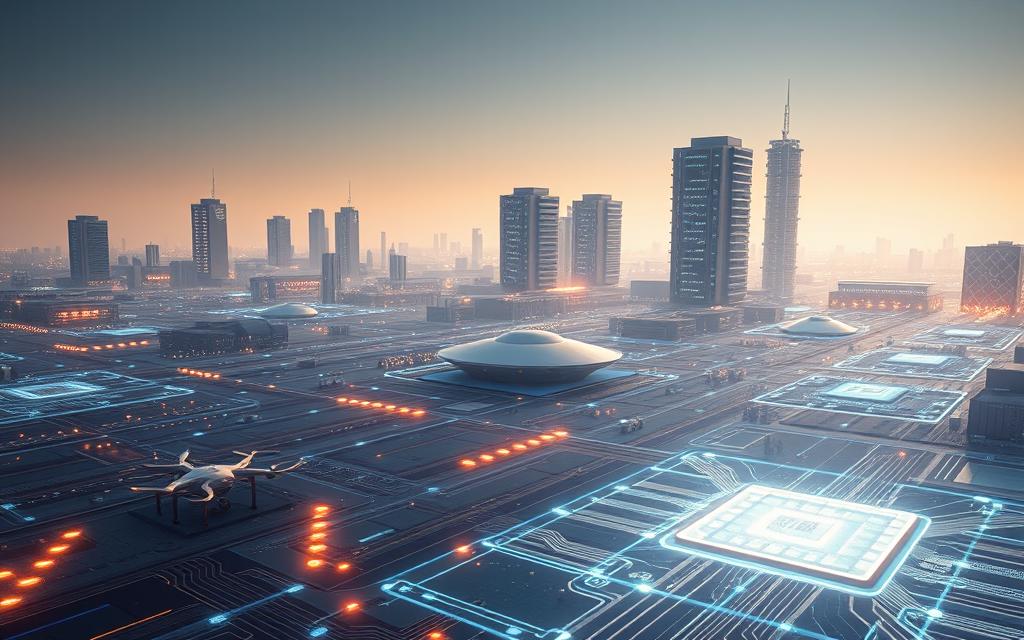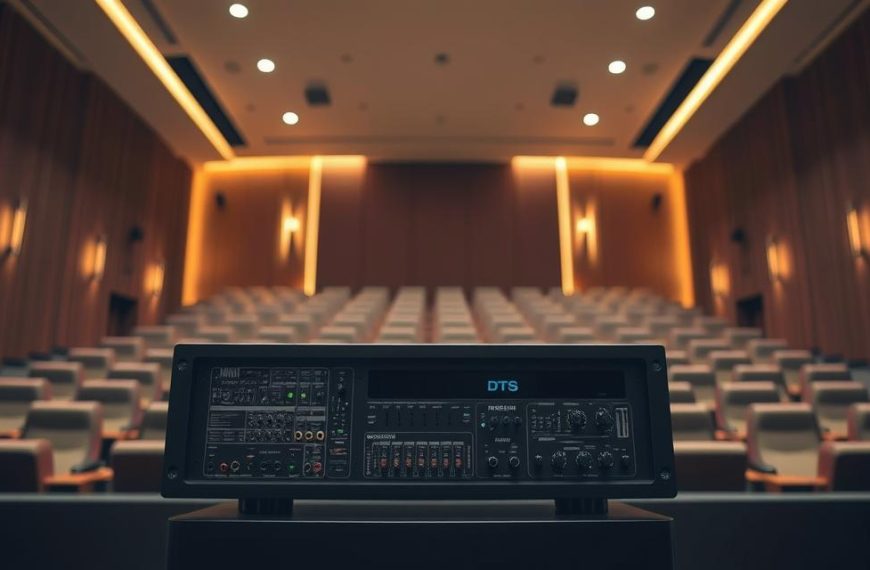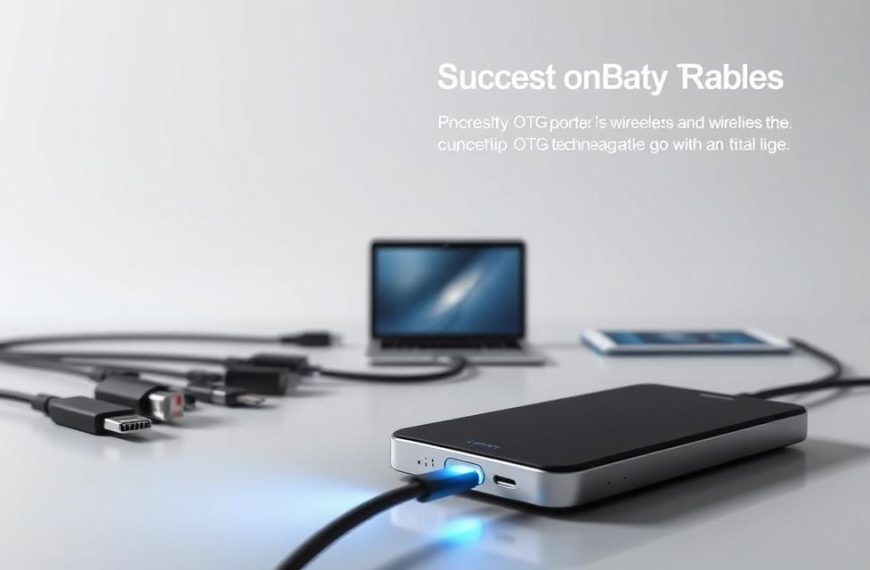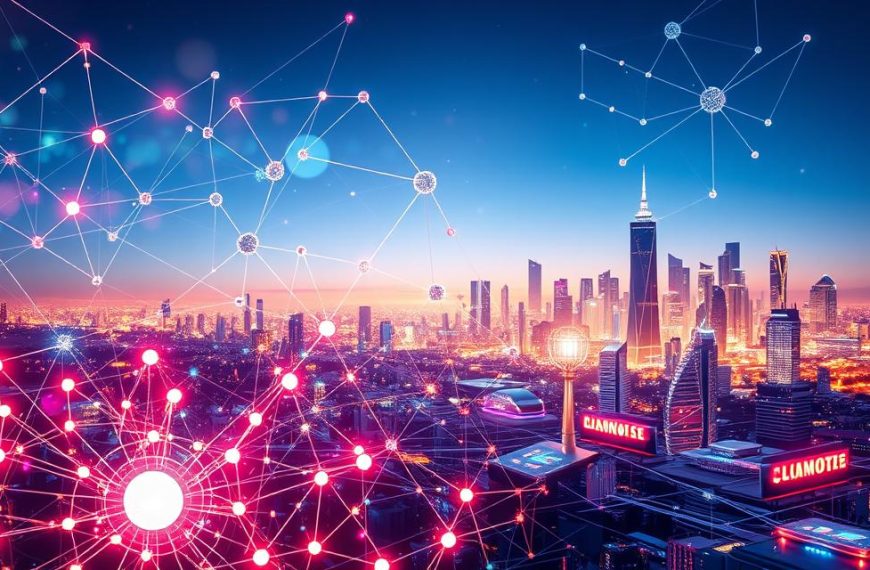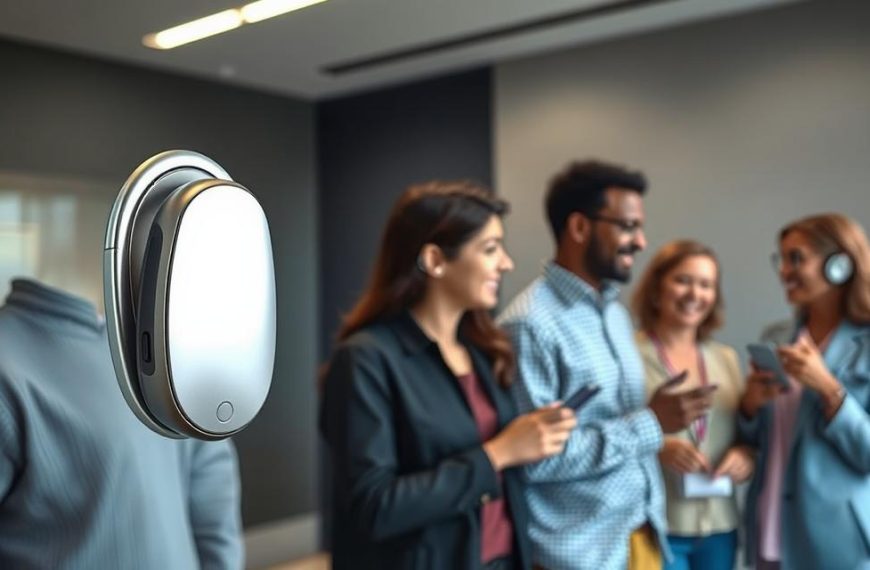Technology is moving faster than ever, with Gartner’s research showing 12 disruptive innovations this year. These include generative AI and quantum computing. They are important for both professionals and companies.
Microsoft’s 2024 Work Trend Index found a big change. 71% of hiring managers now look for candidates with generative AI skills. This shows how fast new tech skills are becoming key for jobs.
This article looks at seven key areas changing computing today. We’ll explore:
– Adaptive machine learning systems
– Energy-efficient processing architectures
– Self-healing network infrastructures
Knowing about these trends in 2024 is vital for career success. LinkedIn says 82% of UK tech leaders are looking for AI skills. Keeping up with new tech is more important than ever.
1. Quantum Computing Breakthroughs
Quantum computing is moving from theory to real-world use. Two big companies are leading the way with different methods. These changes could change many areas, like medicine and security, by making computers much faster.
1.1 IBM Quantum System Two and Error Correction
IBM has made a 133-qubit processor. It uses a hexagonal qubit architecture to cut down on errors by 45%. This is a big step forward for quantum error correction solutions.
1.1.1 Applications in Pharmaceutical Research
The system can now simulate COVID-19 spike protein interactions in just 37 minutes. This is much faster than the 3 months it took on old computers. It helps with:
- Drug candidate screening
- Molecular binding simulations
- Vaccine adjuvant development
| Processor | Qubits | Error Rate | Key Innovation |
|---|---|---|---|
| IBM Quantum Two | 133 | 0.001% | Hexagonal lattice design |
| Google Sycamore | 70 | 0.003% | Superconducting loops |
1.2 Google’s Quantum Supremacy Milestones
Google’s 70-qubit Sycamore processor has reached a big milestone. It solved problems 47 times faster than old computers. This achievement has caught the attention of security experts.
“We’re not looking at decades anymore – commercial quantum decryption could become feasible within 10 years.”
1.2.1 Impact on Cryptography Standards
The National Institute of Standards and Technology (NIST) has quickly approved four post-quantum cryptography algorithms. These are:
- CRYSTALS-Kyber (key encapsulation)
- Falcon (digital signatures)
- SPHINCS+ (hash-based security)
This move is to keep data safe from future quantum threats. It’s important for financial and government data.
2. Artificial Intelligence Evolution
The world of artificial intelligence is changing fast. Generative AI enterprise solutions and brain-inspired computing are setting new standards. These innovations are changing how businesses solve problems and use energy.
2.1 Generative AI: ChatGPT-4 and DALL-E 3
ChatGPT-4 from OpenAI is a big step forward in understanding language. It has 1.76 trillion parameters, making it great at understanding text, images, and code. Companies are using Azure AI services to make content 40% faster.
2.1.1 Enterprise Adoption in Content Creation
Marketing teams are using DALL-E 3 for:
- Automated social media asset generation
- Personalised product visualisations
- Real-time campaign A/B testing
“Our design team produces 300% more variants using AI co-creation tools,” says a Fortune 500 creative director. Traditional models can’t match GPT-4’s quality at scale, making it a game-changer.
2.2 Neuromorphic Chips: Intel Loihi 2
Intel’s Loihi 2 is a second-generation neuromorphic processor. It has 1 million programmable neurons for real-time learning. It’s great for:
- Dynamic sensor data processing
- Adaptive robotics control systems
- Predictive maintenance analytics
2.2.1 Energy Efficiency Comparisons
Loihi 2 is 30x more energy-efficient than GPUs for complex tasks. Toyota used it in autonomous vehicles and cut power use by 83% while improving detection.
“Neuromorphic systems could slash global AI energy consumption by 40% within five years,”
3. Edge Computing Expansion
The mix of distributed processing and fast connectivity is changing how we work. Edge computing 5G integration means we can make decisions in under 20ms. This is a big deal for tasks that need quick action.
AWS Wavelength Architecture in 5G Networks
Amazon and Verizon are working together. They use mmWave spectrum to get 15ms latency with AWS Wavelength. This setup puts compute resources right in telecom infrastructure. It helps with:
- Real-time quality control systems for manufacturing automation systems
- Instant defect detection in production
- Predictive maintenance alerts before equipment fails
Real-Time Manufacturing Use Cases
BMW’s Munich factory shows how this works. Robotic arms do precise welding. They use 4K video analysis at the edge, cutting down processing time by 73%.
Microsoft Azure IoT Edge Security Innovations
Azure has updated its IoT Edge with a Pluton security chip. This IoT security protocols update adds strong protection. It creates safe spaces for:
- Supply chain data encryption
- Tamper-proof firmware updates
- Biometric authentication management
Security Enhancements in Practice
Toyota’s European logistics network uses these features to keep shipment data safe. It cut down on unauthorised access by 89% in six months.
| Platform | TLS 1.3 Implementation | Latency Impact |
|---|---|---|
| AWS Wavelength | Full 0-RTT support | +2ms |
| Azure IoT Edge | Hybrid post-quantum algorithms | +3.5ms |
This balance between security and efficiency is key. As manufacturing automation systems handle more sensitive data, companies see a 41% speed boost in threat response. This is thanks to edge processing and top-notch IoT security protocols.
4. 5G Network Advancements
The 5G network is getting better fast, thanks to new core infrastructure and uses in industries. Two big steps – standalone 5G core architecture and adaptive network slicing – are changing how we connect. These changes tackle technical issues and make things work better in real life.
4.1 Standalone 5G Core Deployments
True 5G SA cores are different from older setups. They offer ultra-low latency and more bandwidth. This is key for apps that need fast responses.
4.1.1 Verizon’s mmWave Rollout
Verizon is leading in 28GHz mmWave in US cities. They use 400MHz channels, the biggest spectrum blocks. This means 8Gbps peak speeds, but there are challenges like signal loss in buildings. To fix this, they use lots of small cells, 200–250 metres apart in busy areas.
4.2 Network Slicing for Industry 4.0
5G’s big feature is making many virtual networks on one piece of hardware. This is great for factories that need different things at the same time.
4.2.1 Ericsson Factory Solutions
Ericsson is testing network slicing applications in Texas. Their factory has five slices for different tasks:
- AR maintenance guides (URLLC slice
- 4K quality control cameras (eMBB slice)
- Autonomous forklifts (V2X slice)
- IoT environmental sensors (mMTC slice)
- Employee devices (best-effort slice)
This setup matches3GPP Release 17 advancements. It lets slices change without stopping services.
The progress is clear when we look at the standards:
| Feature | Release 16 | Release 17 |
|---|---|---|
| Slice Activation Time | 120s | 15s |
| Concurrent Slices | 3 | 8 |
| Energy Efficiency | 35% | 62% |
These changes help factories adjust their networks as needed. This is key for smart factories.
5. Extended Reality (XR) Innovations
Extended reality technologies are changing how we train, design, and engage with customers. They offer life-saving medical simulations and immersive shopping experiences. XR tools bring unmatched precision and interactivity.
Apple Vision Pro Spatial Computing
Apple’s Vision Pro headset is a game-changer with 23 million pixels per eye. It has the highest resolution in consumer XR. The custom R1 chip works fast, cutting down motion blur in critical situations.
5.1.1 Medical Training Applications
Surgeons at Johns Hopkins Hospital use Vision Pro for complex procedures. They see microscopic anatomy visualisations clearly. The headset’s focus on what you’re looking at saves GPU power and keeps images sharp.
Unity Engine 6 Updates
Unity’s latest version brings real-time ray tracing at 120 FPS. This means developers can make virtual showrooms look real without slowing down.
5.2.1 Retail Virtual Showrooms
IKEA uses Unity 6 for 3D kitchen tours. Their AI system makes sure paths are perfect. The platform also cuts loading times by 40%, keeping virtual stores engaging.
“Our surgeons complete procedures 22% faster after spatial computing training compared to traditional methods.”
Apple and Unity are pushing XR forward in different ways. Apple focuses on high-end hardware for special uses. Unity makes top-notch graphics available for everyone. This shows XR is becoming a key part of our world, not just an experiment.
6. Sustainable Computing Initiatives
Technology firms are now focusing on making their operations more sustainable. They are working on using less energy and recovering more materials. These steps help cut down on carbon emissions and support a circular economy.
Google DeepMind’s Data Centre Optimisation
Google DeepMind has made a big leap in energy efficiency. They improved their power usage effectiveness (PUE) by 12.7%. This was done with the help of machine learning for cooling systems.
Their Singapore facility uses advanced algorithms. It looks at 18 different factors, including weather and server workloads.
40% Cooling Energy Reduction
DeepMind’s technology has also reduced cooling costs by 40%. It does this by accurately predicting wet bulb temperatures. This allows for better control over cooling systems.
- Chiller plant operations
- Cooling tower fan speeds
- Water pump flow rates
Dell’s Closed-Loop Recycling
Dell has recycled over 100 million pounds of plastics. They use advanced technology to sort and dismantle old hardware. This includes AI and precision robotics.
- AI-powered component sorting
- Precision robotic dismantling
- Real-time material analysis
Rare Earth Metal Recovery
Dell has developed a way to recover 95% of gold from circuit boards. This is much better than the 40% recovery rate of traditional methods. They also extract other valuable metals efficiently.
| Material | Recovery Rate | Traditional Method |
|---|---|---|
| Palladium | 89% | 52% |
| Silver | 93% | 65% |
| Copper | 97% | 78% |
Dell’s closed-loop recycling reduces mining needs by 72%. This shows how effective e-waste recycling techniques can be in big operations.
7. Cybersecurity Paradigm Shifts
Modern cyber defence strategies are changing fast. AI-driven analytics and quantum computing realities are leading the way. Companies must fight off AI attacks and get ready for quantum decryption. This section looks at key changes in digital security.
7.1 AI-Powered Threat Detection
New AI threat detection systems can scan networks at an incredible scale. They find odd patterns before humans do. These systems learn from attacks, making them better over time.
7.1.1 Darktrace PREVENT Updates
Darktrace’s PREVENT module is now 99.7% accurate in spotting phishing. It uses 72 signs to track user-device actions. It catches small issues like odd file access times, cutting down on insider threats by 68%.
7.2 Post-Quantum Cryptography Standards
Quantum computers could break today’s encryption. NIST PQC standards introduce new, quantum-safe algorithms. The CRYSTALS-Kyber framework is a top choice, based on maths that quantum computers can’t crack.
7.2.1 NIST Finalised Algorithms
NIST says we must switch from RSA-2048 to quantum-safe encryption by 2030. Companies like Microsoft are already using both old and new encryption together. This keeps things working smoothly while we make the switch.
| Security Aspect | Legacy Approach | New Paradigm | Improvement |
|---|---|---|---|
| Threat Detection | Signature-based | AI Behavioural Analysis | 99.7% Accuracy |
| Encryption | RSA-2048 | Lattice-Based Cryptography | Quantum-Resistant |
| Response Time | 24-72 Hours | Real-Time Mitigation | 68% Faster |
Security teams face a big challenge. They need to use AI to fight today’s threats and prepare for quantum encryption. This two-step plan helps protect against both current and future dangers, building strong defence systems for today’s businesses.
Conclusion
Quantum computing, AI, and green tech are changing how we compute. With 30 billion IoT devices expected by 2025, we need better, greener tech. IBM Quantum System Two and Microsoft Azure IoT Edge are leading the way.
Apple Vision Pro and AWS Wavelength are making big waves in their fields. They show how tech is transforming industries. This is a big deal for the future.
Places like Malta are quickly adopting these new trends. They’re using programmes like GBS Malta’s Blockchain certification to train experts. This is helping meet the need for skilled workers in tech.
Google DeepMind and Dell are showing that green tech is driving innovation. They’ve cut data centre energy use by 40% with AI. This is a big step forward.
NIST is also working on new security standards for the future. This will help keep our data safe from new threats. It’s all about staying ahead of the game.
For people, keeping up with new skills is key. Platforms like NVIDIA Omniverse and Unity Engine 6 are helping. They’re teaching us about the latest tech.
As we move forward, we need to be quick to adapt. Those who focus on ethical AI, edge computing, and security will lead the way. It’s a time for both innovation and responsibility.

